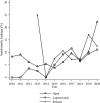Risk Factors for Anastomotic Leakage in Patients with Rectal Tumors Undergoing Anterior Resection within an ERAS Protocol: Results from the Swedish ERAS Database
- PMID: 33733700
- PMCID: PMC8093169
- DOI: 10.1007/s00268-021-06054-y
Risk Factors for Anastomotic Leakage in Patients with Rectal Tumors Undergoing Anterior Resection within an ERAS Protocol: Results from the Swedish ERAS Database
Abstract
Background: Research on risk factors for anastomotic leakage (AL) alone within an Enhanced Recovery After Surgery (ERAS) protocol has not yet been conducted. The aim of this study was to identify risk factors for AL and study short-term outcome after AL in patients operated with anterior resection (AR).
Methods: All prospectively and consecutively recorded patients operated with AR in the Swedish part of the international ERAS® Interactive Audit System (EIAS) between January 2010 and February 2020 were included. The cohort was evaluated regarding risk factors for AL and short-term outcomes, including uni- and multivariate analysis. Pre-, intra- and postoperative compliance to ERAS®Society guidelines was calculated and evaluated.
Results: Altogether 1900 patients were included, 155 (8.2%) with AL and 1745 without AL. Male gender, obesity, peritoneal contamination, year of surgery 2016-2020, duration of primary surgery and age remained significant predictors for AL in multivariate analysis. There was no significant difference in overall pre- and intraoperative compliance to ERAS®Society guidelines between groups. Only preadmission patient education remained as a significant ERAS variable associated with less AL. AL was associated with longer length of stay (LOS), higher morbidity rate and higher rate of reoperations.
Conclusion: Male gender, obesity, peritoneal contamination, duration of surgery, surgery later in study period, age and preadmission patient education were associated with AL in patients operated on with AR. Overall pre- and intraoperative compliance to the ERAS protocol was high in both groups and not associated with AL.
Conflict of interest statement
The first author, Daniel Asklid, the third author Yin Xu and the last author Ulf O Gustafsson declare no conflict of interest. The second author Olle Ljungqvist is the chairman and co-founder of the ERAS Society, and he is the founder and shareholder of Encare AB, a software company that develops the ERAS Interactive Audit System.
Figures
Similar articles
-
Short-term outcome in robotic vs laparoscopic and open rectal tumor surgery within an ERAS protocol: a retrospective cohort study from the Swedish ERAS database.Surg Endosc. 2022 Mar;36(3):2006-2017. doi: 10.1007/s00464-021-08486-y. Epub 2021 Apr 15. Surg Endosc. 2022. PMID: 33856528 Free PMC article.
-
Risk factors for anastomotic leakage in colonic procedures within an ERAS-protocol. A retrospective cohort study from the Swedish part of the international ERAS-database.World J Surg. 2024 Jul;48(7):1749-1758. doi: 10.1002/wjs.12205. Epub 2024 May 8. World J Surg. 2024. PMID: 38719788
-
The effect of diverting stoma on postoperative morbidity after low anterior resection for rectal cancer in patients treated within an ERAS program.Eur J Surg Oncol. 2015 Jun;41(6):724-30. doi: 10.1016/j.ejso.2015.03.234. Epub 2015 Apr 12. Eur J Surg Oncol. 2015. PMID: 25908011
-
Delayed anastomotic leakage following laparoscopic intersphincteric resection for lower rectal cancer: report of four cases and literature review.World J Surg Oncol. 2017 Aug 1;15(1):143. doi: 10.1186/s12957-017-1208-2. World J Surg Oncol. 2017. PMID: 28764707 Free PMC article. Review.
-
Does conversion during laparoscopic rectal oncological surgery increases postoperative complications and anastomotic leakage rates? A meta-analysis.J Visc Surg. 2020 Aug;157(4):277-287. doi: 10.1016/j.jviscsurg.2019.12.004. Epub 2019 Dec 20. J Visc Surg. 2020. PMID: 31870627
Cited by
-
Diverting stomas reduce reoperation rates for anastomotic leak but not overall reoperation rates within 30 days after anterior rectal resection: a national cohort study.Int J Colorectal Dis. 2022 Jul;37(7):1681-1688. doi: 10.1007/s00384-022-04205-8. Epub 2022 Jun 24. Int J Colorectal Dis. 2022. PMID: 35739403 Free PMC article.
-
The Latest Results and Future Directions of Research for Enhanced Recovery after Surgery in the Field of Colorectal Surgery.Ewha Med J. 2023 Dec;46(Suppl 1):e23. doi: 10.12771/emj.2023.e23. Epub 2023 Dec 31. Ewha Med J. 2023. PMID: 40703216 Free PMC article. Review.
-
Predictors That Identify Complications Such As Anastomotic Leak in Colorectal Surgery: A Systematic Review.Cureus. 2022 Sep 7;14(9):e28894. doi: 10.7759/cureus.28894. eCollection 2022 Sep. Cureus. 2022. PMID: 36105895 Free PMC article. Review.
-
Trends in risk factors of anastomotic leakage after colorectal cancer surgery (2011-2019): A Dutch population-based study.Colorectal Dis. 2021 Dec;23(12):3251-3261. doi: 10.1111/codi.15911. Epub 2021 Oct 7. Colorectal Dis. 2021. PMID: 34536987 Free PMC article.
-
Incidence and risk factors of blowout within 90 days after a primary Hartmann's procedure: a retrospective cohort study.Langenbecks Arch Surg. 2023 Jul 14;408(1):275. doi: 10.1007/s00423-023-02967-5. Langenbecks Arch Surg. 2023. PMID: 37442862 Free PMC article.
References
-
- McDermott FD, et al. Systematic review of preoperative, intraoperative and postoperative risk factors for colorectal anastomotic leaks. Br J Surg. 2015;102(5):462–479. - PubMed
-
- Pommergaard HC, et al. Preoperative risk factors for anastomotic leakage after resection for colorectal cancer: a systematic review and meta-analysis. Colorectal Dis. 2014;16(9):662–671. - PubMed
Publication types
MeSH terms
LinkOut - more resources
Full Text Sources
Other Literature Sources
Research Materials



